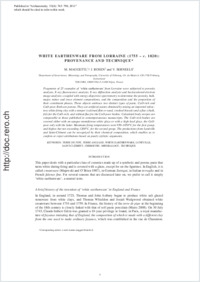White earthenware from Lorraine (1755 –c. 1820): provenance and technique
- Maggetti, Marino Department of Geosciences, Mineralogy and Petrography, University of Fribourg, Switzerland
- Rosen, J. DR CNRS, UMR 5594, Dijon, France
- Serneels, Vincent Department of Geosciences, Mineralogy and Petrography, University of Fribourg, Switzerland
-
14.06.2011
Published in:
- Archaeometry. - 2011, vol. 53, no. 4, p. 765–790
terre de pipe
terre anglaise
white earthenware
lunéville
saint-clément
chemistry
mineralogy
technique
English
Fragments of 25 examples of ‘white earthenware’ from Lorraine were subjected to porosity analysis, X-ray fluorescence analysis, X-ray diffraction analysis and backscattered-electron image analysis—coupled with energy-dispersive spectrometry to determine the porosity, bulk, major, minor and trace element compositions, and the composition and the proportion of their constituent phases. These objects embrace two distinct types of paste, CaO-rich and CaO-poor. Both are porous. They are artificial pastes obtained by mixing an imported refractory white firing clay with a temper (calcined flint or sand, crushed biscuit) and a flux (chalk, frit) for the CaO-rich, and without flux for the CaO-poor bodies. Calculated body recipes are comparable to those published in contemporaneous manuscripts. The CaO-rich bodies are covered either with an opaque stanniferous white glaze or with a high-lead glaze, the CaO-poor only with the latter. Maximum firing temperatures were 950–1050°C for the first group, and higher, but not exceeding 1200°C, for the second group. The productions from Lunéville and Saint-Clément can be recognized by their chemical composition, which enables us to confirm or reject attributions based on purely stylistic arguments.
- Faculty
- Faculté des sciences et de médecine
- Department
- Département de Géosciences
- Language
-
- English
- Classification
- Mineralogy
- License
-
License undefined
- Identifiers
-
- RERO DOC 28033
- DOI 10.1111/j.1475-4754.2010.00563.x
- Persistent URL
- https://folia.unifr.ch/unifr/documents/302107
Statistics
Document views: 158
File downloads:
- pdf: 249
